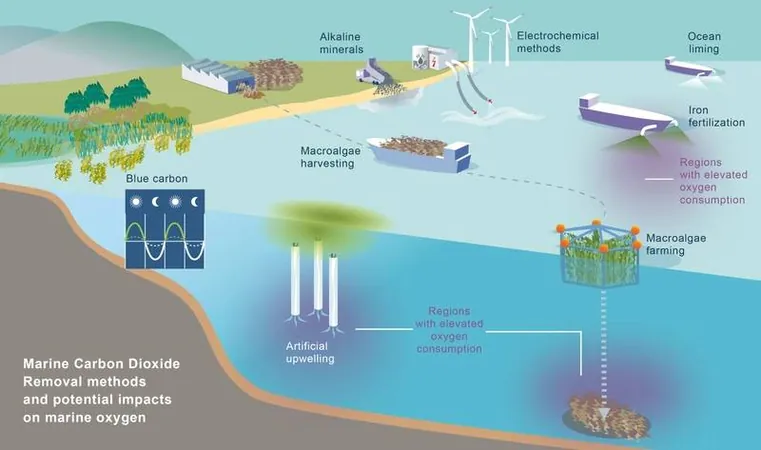
The Dangerous Side of Carbon Capture: Could It Suffocate Our Oceans?
2025-06-16
Author: Nur
As the battle against climate change intensifies, innovative methods to boost the ocean's carbon dioxide absorption are being explored. However, these strategies may come with unintended consequences, significantly worsening ocean deoxygenation.
A team of researchers, spearheaded by Prof. Dr. Andreas Oschlies from the GEOMAR Helmholtz Centre for Ocean Research Kiel, warns that the potential impacts on marine oxygen levels must be carefully evaluated. The global warming crisis is already causing a staggering two percent decline in ocean oxygen over recent decades, and projections indicate that this troubling trend will worsen.
Recent findings highlight that many carbon dioxide removal (CDR) methods, especially those rooted in biological processes, could aggravate this oxygen depletion. "What’s beneficial for the climate doesn’t automatically translate to being safe for our oceans," Oschlies cautions.
In collaboration with experts from the UNESCO Global Ocean Oxygen Network (GO2NE), the research team conducted robust global model simulations to assess both direct and indirect effects of various marine CDR methods on ocean oxygen levels. Their alarming results have been published in Environmental Research Letters.
The study pinpointed several biotic CDR strategies as particularly concerning, including ocean fertilization, extensive macroalgae cultivation followed by biomass sinking, and artificial upwelling of nutrient-rich waters. These initiatives may enhance photosynthetic biomass, but the inevitable decomposition process consumes vital oxygen, likely at rates comparable to current ocean warming.
Oschlies made a stark statement: "Techniques that boost biomass in the ocean, leading to oxygen-draining decomposition, are not harmless climate solutions." Model simulations indicated that such strategies could trigger a decrease in dissolved oxygen levels that is four to 40 times greater than any gain expected from mitigating global warming.
On a more positive note, geochemical CDR methods, like enhancing ocean alkalinity through the addition of limestone, show minimal impact on oxygen levels and can be likened to simply cutting CO₂ emissions.
Interestingly, the only method that demonstrated an overall increase in oceanic oxygen levels was large-scale macroalgae farming coupled with biomass harvesting. Crucially, this method does not consume additional oxygen, and nutrient removal can help curb oxygen depletion elsewhere.
If implemented on a large scale, this approach holds the potential to reverse previous oxygen losses, potentially generating up to ten times more oxygen than was depleted due to climate change over the last century. However, it's essential to note that nutrient removal could negatively affect biological productivity.
In light of these findings, the authors strongly recommend incorporating regular oxygen monitoring in all future marine carbon dioxide removal projects to safeguard our oceans from unintended harm.




 Brasil (PT)
Brasil (PT)
 Canada (EN)
Canada (EN)
 Chile (ES)
Chile (ES)
 Česko (CS)
Česko (CS)
 대한민국 (KO)
대한민국 (KO)
 España (ES)
España (ES)
 France (FR)
France (FR)
 Hong Kong (EN)
Hong Kong (EN)
 Italia (IT)
Italia (IT)
 日本 (JA)
日本 (JA)
 Magyarország (HU)
Magyarország (HU)
 Norge (NO)
Norge (NO)
 Polska (PL)
Polska (PL)
 Schweiz (DE)
Schweiz (DE)
 Singapore (EN)
Singapore (EN)
 Sverige (SV)
Sverige (SV)
 Suomi (FI)
Suomi (FI)
 Türkiye (TR)
Türkiye (TR)
 الإمارات العربية المتحدة (AR)
الإمارات العربية المتحدة (AR)